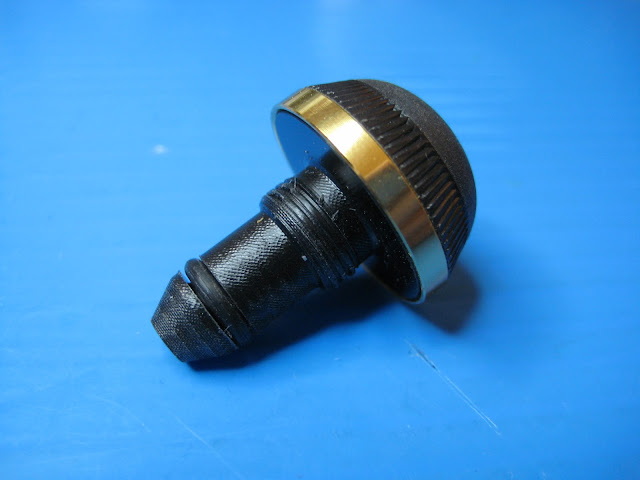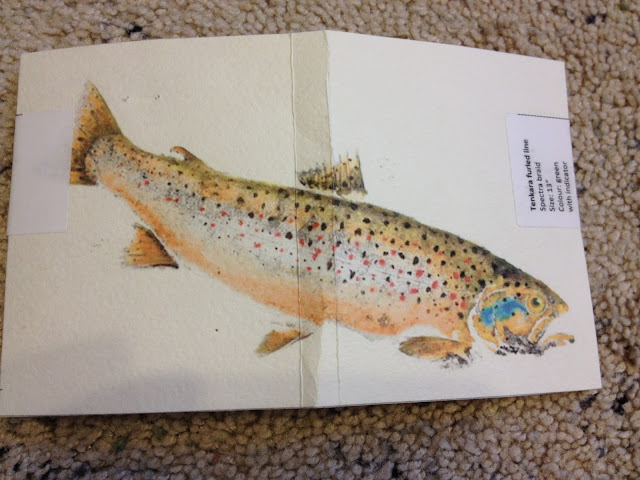I have been fishing small mountain streams lately, as it is their time of year. Recently I picked up a rod that fits these streams perfectly and makes them even funner to fish. The rod is the Nissin Pro Spec 2-Way 7:3 360 36-31 zoom rod.
The rod comes in the classic Japanese tenkara rod plastic carton, but that does not mean it is a toy or "non-serious" rod. Like all of the tenkara rods I have which are either Japanese made or Japanese labeled the quality is in the rod itself and not in the packaging. The rod comes with a rod sock.
The rod is outwardly similar to the Nissin ZeroSum 7:3 that I reviewed previously, but there are distinct differences. Comparing the two side by side you can tell that certain short cuts have been taken with the Pro Spec 2-Way; these are why it costs less. The handle has the same pronounced gourd or hourglass shape. However, in the case of the Pro Spec 2-Way the handle is cleverly disguised foam. There is a thin cork veneer that makes the handle appear to be cork, but it is not (see the image below). This foam base makes the Pro Spec 2-Way handle a little softer than the ZeroSum. It will be interesting to see how its durability is over time.
The butt cap is similar in shape but since the Pro Spec 2-Way is a zoom rod there is the additional spike to hold the collapsed zoom segment. The color accents are blue, rather than red as with the ZeroSum. The finish is glossy black.
One thing that is different though is the tip cap. The ZeroSum as a fancy gold metal plug, but the Pro Spec has a rubber plug. At first it seem way too large, but if you screw it into the section it collapses and makes a tight fit. Still, I prefer using a Fuji KTC-12 with this rod.
The rod is 57.5 cm collapsed. Extended it can be fished either at 310 cm or 360 cm. It weighs 69.3 gm without the tip plug. The rod is advertised at 75 gm -- that once again goes to show that there can be great variance between what is advertised and what is actual: length, weight, action.
Casting the rod is great fun. The rod is so light and well balanced that it is effortless to cast. It feels a little stiffer in the 3.1 m configuration, but not by much. I like this rod in both it 3.1 and 3.6 m configurations. This is not like the Shimano 34-38 ZL; this rod feels pretty much the same both long and short. If you are looking for a soft 5:5 action rod for small streams, then this rod is not it. Go with it's 6:4 designated sibling and you'll be happier. My rod is categorized by Nissin as a 7:3, but in reality it is more like a softer 6:4. Keep this in mind when you pick it up. See the Rod Flex Index chart below to see where this rod fits when compared to other rods.
I have fished the rod numerous times now; small streams and larger mountain streams. It is pretty much perfect (for me at least) for trout 6-14 inches. I use a #3, 3.5 and 4 line, but I think the #3-3.5 work best. You can throw either unweighted or slightly weighted (small beadhead) flies and the rod won't gripe. The casting action is smooth and unencumbered. I don't detect even a slight tip overshoot or oscillation -- very nice! Personally, I fish the rod mostly in the 3.6 m configuration, but shorten it to 3.1 m when the situation necessitates.
Any concerns? Well, one. Shortly after receiving the rod I was fishing a tight stream and I happened to snag a nearby tree. I'm sure that never happens to any of you but it does to me pretty often. Anyway, I started to "work" the fly by repeatedly snapping the rod backwards away from the tree (using 5X tippet). I do this all the time and usually either the fly comes loose, the tippet breaks, or I eventually have to go extricate the fly manually. This time the 3rd section of the rod snapped near where it contacts section 4. I've never had that happen before, but I suppose I was asking for it. I don't think it was the rod's fault -- it was mine. Lesson learned: I received a replacement part (BTW, there is NO warranty with this rod) I now use 6X with this rod! I don't hold this adverse event against the rod. I think I've just been lucky up 'till now!
Conclusion: What a rod! I haven't been this excited about a lightweight, true tenkara rod in a while. Excellent balance and in-hand feel. I love the handle shape (I have XL size hands) and the fact that the handle is really foam (with a cork veneer) doesn't bother me at all. Playing mountain stream fish is great fun with this rod -- I wouldn't expect rod this to handle a 16+ inch trout in fast current very well however. If you have those in your favorite stream and you decide to use this rod, choose your tippet weight carefully. Anyway you look at it, this rod is a highly versitle tenkara rod designed for tenkara sized trout in tenkara sized streams.
Want one? Contact Chris at Tenkara Bum. I bet they'll go fast.
Here's a video of fishing with this rod:
The rod comes in the classic Japanese tenkara rod plastic carton, but that does not mean it is a toy or "non-serious" rod. Like all of the tenkara rods I have which are either Japanese made or Japanese labeled the quality is in the rod itself and not in the packaging. The rod comes with a rod sock.
The rod is outwardly similar to the Nissin ZeroSum 7:3 that I reviewed previously, but there are distinct differences. Comparing the two side by side you can tell that certain short cuts have been taken with the Pro Spec 2-Way; these are why it costs less. The handle has the same pronounced gourd or hourglass shape. However, in the case of the Pro Spec 2-Way the handle is cleverly disguised foam. There is a thin cork veneer that makes the handle appear to be cork, but it is not (see the image below). This foam base makes the Pro Spec 2-Way handle a little softer than the ZeroSum. It will be interesting to see how its durability is over time.
The butt cap is similar in shape but since the Pro Spec 2-Way is a zoom rod there is the additional spike to hold the collapsed zoom segment. The color accents are blue, rather than red as with the ZeroSum. The finish is glossy black.
 |
| ZeroSum (left) and Pro Spec 2-Way (right) -- see the foam? |
One thing that is different though is the tip cap. The ZeroSum as a fancy gold metal plug, but the Pro Spec has a rubber plug. At first it seem way too large, but if you screw it into the section it collapses and makes a tight fit. Still, I prefer using a Fuji KTC-12 with this rod.
The rod is 57.5 cm collapsed. Extended it can be fished either at 310 cm or 360 cm. It weighs 69.3 gm without the tip plug. The rod is advertised at 75 gm -- that once again goes to show that there can be great variance between what is advertised and what is actual: length, weight, action.
Casting the rod is great fun. The rod is so light and well balanced that it is effortless to cast. It feels a little stiffer in the 3.1 m configuration, but not by much. I like this rod in both it 3.1 and 3.6 m configurations. This is not like the Shimano 34-38 ZL; this rod feels pretty much the same both long and short. If you are looking for a soft 5:5 action rod for small streams, then this rod is not it. Go with it's 6:4 designated sibling and you'll be happier. My rod is categorized by Nissin as a 7:3, but in reality it is more like a softer 6:4. Keep this in mind when you pick it up. See the Rod Flex Index chart below to see where this rod fits when compared to other rods.
I have fished the rod numerous times now; small streams and larger mountain streams. It is pretty much perfect (for me at least) for trout 6-14 inches. I use a #3, 3.5 and 4 line, but I think the #3-3.5 work best. You can throw either unweighted or slightly weighted (small beadhead) flies and the rod won't gripe. The casting action is smooth and unencumbered. I don't detect even a slight tip overshoot or oscillation -- very nice! Personally, I fish the rod mostly in the 3.6 m configuration, but shorten it to 3.1 m when the situation necessitates.
 |
| A 7:3 rod? Really?? Looks more like a slow 6:4 to me. |
Any concerns? Well, one. Shortly after receiving the rod I was fishing a tight stream and I happened to snag a nearby tree. I'm sure that never happens to any of you but it does to me pretty often. Anyway, I started to "work" the fly by repeatedly snapping the rod backwards away from the tree (using 5X tippet). I do this all the time and usually either the fly comes loose, the tippet breaks, or I eventually have to go extricate the fly manually. This time the 3rd section of the rod snapped near where it contacts section 4. I've never had that happen before, but I suppose I was asking for it. I don't think it was the rod's fault -- it was mine. Lesson learned: I received a replacement part (BTW, there is NO warranty with this rod) I now use 6X with this rod! I don't hold this adverse event against the rod. I think I've just been lucky up 'till now!
Conclusion: What a rod! I haven't been this excited about a lightweight, true tenkara rod in a while. Excellent balance and in-hand feel. I love the handle shape (I have XL size hands) and the fact that the handle is really foam (with a cork veneer) doesn't bother me at all. Playing mountain stream fish is great fun with this rod -- I wouldn't expect rod this to handle a 16+ inch trout in fast current very well however. If you have those in your favorite stream and you decide to use this rod, choose your tippet weight carefully. Anyway you look at it, this rod is a highly versitle tenkara rod designed for tenkara sized trout in tenkara sized streams.
Want one? Contact Chris at Tenkara Bum. I bet they'll go fast.
Here's a video of fishing with this rod:


















































